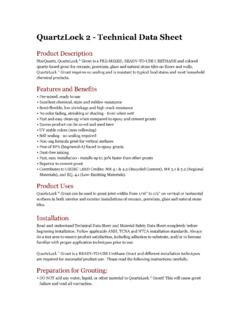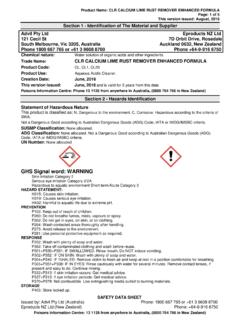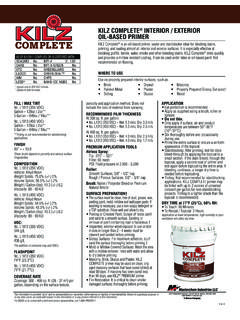Transcription of GHS Signal word: WARNING - De-Solv-it
1 Product Name: De-Solv-it Solution Page: 1 of 6. This version issued: November, 2016. Section 1 - Identification of The Material and Supplier Vardon Industries Phone: 03 9706 4177 (office hours). 4 Kitchen Rd Intl: +61 3 9706 4177. Dandenong South, Vic 3175 Australia Fax: 03 9706 4233 Intl: +61 3 97064233. Chemical nature: Blend of solvents and surfactant. Trade Name: De-Solv-it Solution Product Use: Sticky spot and stain remover. Creation Date: November, 2016. This version issued: November, 2016 and is valid for 5 years from this date. Poisons Information Centre: Phone 13 1126 from anywhere in Australia Section 2 - Hazards Identification Statement of Hazardous Nature This product is classified as: Xn, Harmful. Xi, Irritating.
2 N, Dangerous to the environment. Hazardous according to the criteria of SWA. Not a Dangerous Good according to Australian Dangerous Goods (ADG) Code, IATA or IMDG/IMSBC criteria. SUSMP Classification: S5. ADG Classification: None allocated. Not a Dangerous Good according to Australian Dangerous Goods (ADG). Code, IATA or IMDG/IMSBC criteria. UN Number: None allocated GHS Signal word: WARNING . Flammable liquids Category 4. Aspiration Hazard Category 1. Skin Corrosion /Irritation Category 2. Skin Sensitisation Category 1. Serious eye damage/eye irritation Category 2B. Specific Target Organ Toxicity - Single Exposure Category 3. Hazardous to aquatic environment Short term/Chronic Category 3. HAZARD STATEMENT: H227: Combustible liquid.
3 H304: May be fatal if swallowed and enters airways. H315: Causes skin irritation. H317: May cause an allergic skin reaction. H320: Causes eye irritation. H335: May cause respiratory irritation. H412: Harmful to aquatic life with long lasting effects. PREVENTION. P102: Keep out of reach of children. P210: Keep away from heat, sparks, open flames and hot surfaces. - No smoking. P261: Avoid breathing fumes, mists, vapours or spray. P262: Do not get in eyes, on skin, or on clothing. P264: Wash contacted areas thoroughly after handling. P272: Contaminated work clothing should not be allowed out of the workplace. P273: Avoid release to the environment. P280: Wear protective gloves, protective clothing and eye or face protection.
4 RESPONSE. P362: Take off contaminated clothing and wash before reuse. SAFETY DATA SHEET. Issued by: Vardon Industries Phone: 03 9706 4177 (office hours). Poisons Information Centre: 13 1126 from anywhere in Australia, (0800 764 766 in New Zealand). Product Name: De-Solv-it Solution Page: 2 of 6. This version issued: November, 2016. P301+P310: IF SWALLOWED: Immediately call a POISON CENTRE or doctor. P301+P330+P331: IF SWALLOWED: Rinse mouth. Do NOT induce vomiting. P302+P352: IF ON SKIN: Wash with plenty of soap and water. P305+P351+P338: IF IN EYES: Rinse cautiously with water for several minutes. Remove contact lenses, if present and easy to do. Continue rinsing. P333+P313: If skin irritation or rash occurs: Get medical advice.
5 P337+P313: If eye irritation persists: Get medical advice. P370+P378: In case of fire, use carbon dioxide, dry chemical, foam, water fog. STORAGE. P405: Store locked up. P402+P404: Store in a dry place. Store in a closed container. P403+P235: Store in a well-ventilated place. Keep cool. DISPOSAL. P501: If they can not be recycled, dispose of contents to an approved waste disposal plant and containers to landfill (see Section 13 of this SDS). Emergency Overview Physical Description & Colour: Clear, colourless to pale yellow liquid. Odour: Strong citrus odour. Major Health Hazards: irritating to eyes and skin, possible skin sensitiser, if aspirated, may cause lung damage. Section 3 - Composition/Information on Ingredients Ingredients CAS No Conc,% TWA (mg/m3) STEL (mg/m3).
6 D-limonene 5989-27-5 8-20 not set not set Liquid hydrocarbon 64742-88-7 40-80 not set not set Ethoxylated alcohols (surfactant) 68131-39-5 1-10 not set not set This is a commercial product whose exact ratio of components may vary slightly. Minor quantities of other non hazardous ingredients are also possible. The SWA TWA exposure value is the average airborne concentration of a particular substance when calculated over a normal 8 hour working day for a 5 day working week. The STEL (Short Term Exposure Limit) is an exposure value that may be equalled (but should not be exceeded) for no longer than 15 minutes and should not be repeated more than 4 times per day. There should be at least 60 minutes between successive exposures at the STEL.
7 The term "peak "is used when the TWA limit, because of the rapid action of the substance, should never be exceeded, even briefly. Section 4 - First Aid Measures General Information: You should call The Poisons Information Centre if you feel that you may have been poisoned, burned or irritated by this product. The number is 13 1126 from anywhere in Australia (0800 764 766 in New Zealand) and is available at all times. Have this SDS with you when you call. Inhalation: No first aid measures normally required. However, if inhalation has occurred, and irritation has developed, remove to fresh air and observe until recovered. If irritation becomes painful or persists more than about 30 minutes, seek medical advice. Skin Contact: Wash gently and thoroughly with warm water (use non-abrasive soap if necessary) for 10-20 minutes or until product is removed.
8 Under running water, remove contaminated clothing, shoes and leather goods ( watchbands and belts) and completely decontaminate them before reuse or discard. If irritation persists, repeat flushing and seek medical attention. Eye Contact: Immediately flush the contaminated eye(s) with lukewarm, gently flowing water for 15 minutes or until the product is removed, while holding the eyelid(s) open. Take care not to rinse contaminated water into the unaffected eye or onto the face. Obtain medical attention immediately. Take special care if exposed person is wearing contact lenses. Ingestion: If swallowed, do NOT induce vomiting. Wash mouth with water and contact a Poisons Information Centre, or call a doctor. Section 5 - Fire Fighting Measures Fire and Explosion Hazards: The major hazard in fires is usually inhalation of heated and toxic or oxygen deficient (or both), fire gases.
9 There is little risk of an explosion from this product if commercial quantities are involved in a fire. Violent steam generation or eruption may occur upon application of direct water stream on hot liquids. Vapours from this product are heavier than air and may accumulate in sumps, pits and other low-lying spaces, forming potentially explosive mixtures. They may also flash back considerable distances. SAFETY DATA SHEET. Issued by: Vardon Industries Phone: 03 9706 4177 (office hours). Poisons Information Centre: 13 1126 from anywhere in Australia, (0800 764 766 in New Zealand). Product Name: De-Solv-it Solution Page: 3 of 6. This version issued: November, 2016. Fire decomposition products from this product may be toxic if inhaled.
10 Take appropriate protective measures. Extinguishing Media: In case of fire, use carbon dioxide, dry chemical, foam, water fog. Fire Fighting: If a significant quantity of this product is involved in a fire, call the fire brigade. Flash point: 62 C. Upper Flammability Limit: 7%. Lower Flammability Limit: Autoignition temperature: >200 C. Flammability Class: Flammable Category 4 (GHS), C1 combustible (AS 1940). Section 6 - Accidental Release Measures Accidental release: In the event of a major spill, prevent spillage from entering drains or water courses. Wear full protective clothing including eye/face protection. All skin areas should be covered. See below under Personal Protection regarding Australian Standards relating to personal protective equipment.






